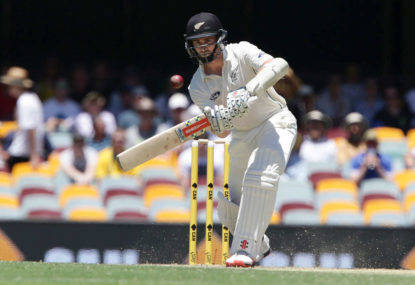A superb bowling display has placed Australia in a wonderful position from which to win this first Test against New Zealand. Yet the Kiwis are not as down and out as the scoreboard suggests, with a fragile Australian tail within sight.
As regularly as Australia’s top six have faltered over the past few years, their lower order has hauled them out of the dirt.
So strong was their tail that down at 10 they often boasted Ryan Harris, a dynamic striker of the ball who averaged 22 with the bat in his Test career.
Gone also is regular number eight Mitchell Johnson, who played some magnificent innings for Australia, as well as Mitchell Starc and James Pattinson, who combined have made 1031 runs at 28 in Tests.
Australia now have a number eight who averages 14 with the bat in Peter Siddle. Given that the two men in front of him – Peter Nevill and Mitchell Marsh – are yet to prove themselves with the blade in Tests, the Kiwis will know this morning they are just one wicket away from accessing this Australian side’s greatest weakness.
Given the pressure associated with chasing a score in the fourth innings away from home, Australia will not feel any level of comfort unless they can earn a solid first innings lead of at least 50 to 60 runs.
That target is still about 100 runs away. On a pitch which tests the patience and technique of batsmen, against a Kiwi attack well suited to such conditions, Australia have plenty of work left to complete before earning a truly commanding position in the Test.
History suggests this Wellington pitch can change quite dramatically in behaviour as the match wears on, morphing from one which aids the bowlers into a batting nirvana. Even across the course of day one the deck appeared to become less difficult.
The Test now seems to hinge on this morning’s session when the pitch should be at its softest and carrying some moisture. If Adam Voges and Usman Khawaja are able to withstand the opening salvo from the Kiwis then batting should get much easier and their middle-to-lower order may be able to enjoy batting and build an impregnable lead.
Conversely, an early wicket would leave Australia in danger of being rolled for not much more than New Zealand’s meagre total of 183. The Kiwis exploited the new ball yesterday but were unable to capitalise on their two early wickets in the same way as the Australian seamers kept hounding the New Zealand top seven.
Amid the carnage of yesterday’s first hour, after which the Kiwis were five wickets down, superstar Kane Williamson continued his recent run of failing on tracks which offer something to the bowlers.
Australian guns Steve Smith and David Warner are constantly labelled flat track bullies, and compared unfavourably to the more classical Williamson. Yet the Kiwi is developing his own habit of cashing in on docile decks and faltering on more difficult surfaces.
The last three Tests in which Williamson has faced a decent pace attack on a pitch offering them some assistance he has made scores of 0, 6, 22, 9 and 16 for a total of 53 runs at an average of 11.
Nine months ago in England, the Kiwi first drop plundered the Poms on a flat deck at Lord’s but then, confronted with a trickier pitch at Leeds, he made 0 and 6.
In Australia, Williamson flayed the home attack on batsman-friendly surfaces at Brisbane and Perth, before failing in both innings once conditions became more difficult at Adelaide, making 22 and 9.
Yesterday he again was tripped up on a pitch when the bowling wasn’t gun-barrel straight, dismissed for 16 playing an unnecessary drive at a Peter Siddle off cutter.
Does this sequence of failures when circumstances are a bit challenging prove Williamson is a flat track bully? No, it doesn’t. There’s not a sane cricket fan in the world who doesn’t rate him as a truly elite batsman.
What it does show is how significantly perception affects the way we view player performance. The perception of Williamson, due to his neat technique and unflappable temperament, is that he’s tailor made for grafting runs under duress. When he fails to do so, no-one takes great notice.
Meanwhile, the perception of Smith and Warner is that they are flashy, idiosyncratic batsmen, a style which surely can only prosper when the going is easy. As a result, many people are waiting for that pair to stumble when the ball is moving so they can affirm their perceptions.
The reality is that almost all modern batsmen are far more vulnerable the moment the ball starts to so much as wobble off the pitch. It’s a by-product of the heinously-flat surfaces served up over and over in all three formats of the game these days.
Unfortunately, Australia quickly is becoming the worst offender in this regard, regularly producing Test, ODI and T20 pitches which favour the batsmen so much as to tarnish the game.
Cricket followers and fans are swift to lambast batsmen when they can’t counter the moving ball, branding them ‘flat track bullies’ and the like. How, though, can they be expected to master such circumstances, when they so very rarely are exposed to them?





























































































